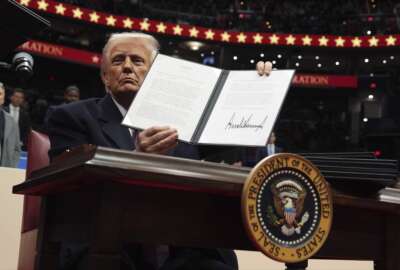Connolly: Budget uncertainty has ‘insidious impact’ on feds, contractors
A bevy of issues has piled up on lawmakers' to-do list, including fiscal 2014 funding and a pay raise for federal employees. But they don't have much time to act.
wfedstaff | April 17, 2015 5:28 pm
A bevy of issues has piled up on lawmakers’ to-do list: Whether to block or support a modest pay raise for federal employees, hammering out a deal on funding the government beyond the end of the fiscal year and the looming fight over raising the debt ceiling in mid-October.
But lawmakers don’t have that much time. The current fiscal year ends Sept. 30, and there are just nine legislative days left when they return from their summer recess next week.
For Congress, the tight timelines have become all too common.
“Governing by crisis is very unwise and frankly injurious to the country. … It costs money, it creates uncertainty for businesses as well as for the government and the taxpayers we serve, and it’s very bad public policy,” Rep. Gerry Connolly (D-Va.) told In Depth with Francis Rose in a recent interview.
Most observers expect Congress to work out a short-term continuing resolution to keep the government funded past the end of the month, which would avert a government shutdown. But it’s unclear how lawmakers plan to account for the automatic budget cuts, known as sequestration, in their spending plans. In fact, the House and the Senate have, so far, settled on divergent paths — and remain more than $91 billion apart.
That all spells out widespread budget uncertainty for both federal employees and contractors.
“I face both sets of issues,” said Connolly, whose Northern Virginia district contains large numbers of both. “And all of those constituents are concerned about federal cutbacks and the uncertainty about the budget and the debt ceiling and what it might mean in terms of a potential government shutdown or further contractions in federal investments.”
In particular, the climate of uncertainty calls into question contractors’ ability to compete for and complete long-term projects and precludes long-term investments by the federal government, Connolly said.
“As a result, you have this insidious, unseen impact of ‘We’re going to hold back,'” he said. “And that’s happening all over in the federal contracting world and directly in the federal government, itself. Agency heads are understandably reluctant to make any kind of long-term commitment for themselves or for their outside contractors.”
Pay raise still on table
Last week, President Barack Obama announced his support for a 1 percent federal pay raise, reiterating a proposal he first put forward in his 2014 budget proposal earlier this year. Federal employees have had their pay frozen since January 2011.
Connolly supports the raise but said he believes Republicans in Congress may block the measure from going into effect.
“This is a very, very modest attempt at trying to break the pay freeze,” Connolly said. “I applaud the president for that, because there’s symbolism in that and an important policy issue that needs to be addressed. But I’m frankly not hopeful that the Republicans are going to budge on this.”
Last year, for instance, Obama proposed an even smaller 0.5 percent pay raise. However, lawmakers — including Senate Democrats — blocked the pay increase as part of a broader government-funding deal.
Connolly said he worries extending the pay freeze would have a negative impact on federal employees.
“How are we going to recruit and replace and retain the workforce of the future — especially in the higher skill set — if we’re treating the workforce this way?” he asked. “And I find it ironic that a crowd that says we ought to run the government like a company actually is engaged in management practices that no company worth its salt would ever engage in.”
RELATED STORIES:
Agencies’ FY 2015 budget planning ‘tied up in knots’ by uncertainty
Obama ends federal pay freeze; Congress could still block
Treasury says US will hit debt limit in mid-Oct
Copyright © 2025 Federal News Network. All rights reserved. This website is not intended for users located within the European Economic Area.





